Lenovo Legion 5i 17 review – they have done it again
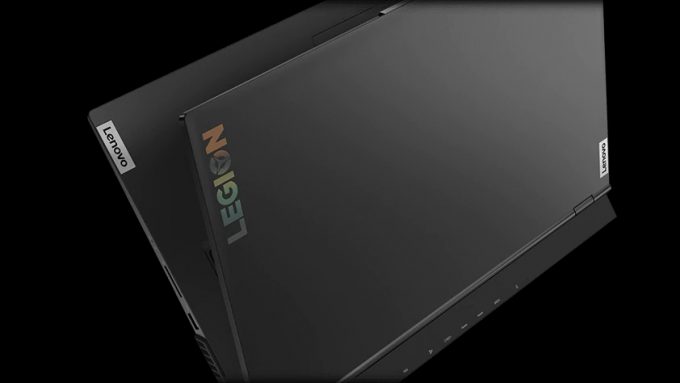 Ladies and gentlemen, today we have a prime contender for the crown in the budget 17-inch gaming segment. It is the Lenovo Legion 5i 17, where “i” stands for Intel. Indeed, it comes in two iterations – the one we have here, and an AMD-equipped one. And if your main purpose is gaming, the Intel one is probably the better option for now.
Ladies and gentlemen, today we have a prime contender for the crown in the budget 17-inch gaming segment. It is the Lenovo Legion 5i 17, where “i” stands for Intel. Indeed, it comes in two iterations – the one we have here, and an AMD-equipped one. And if your main purpose is gaming, the Intel one is probably the better option for now.
You see, the Legion notebooks are getting better and better each year. They provide a very non-intrusive look, with adequate displays and quite the amount of performance. Now, in 2020, Lenovo is offering Wi-Fi 6 support, and a choice from some rather efficient, and powerful graphics cards, starting from the GTX 1650, and going up to the RTX 2060, where we’re no longer in budget gaming territory.
So let’s see what can this 17-inch machine provide, considering that the 15-inch model was pretty much flawless.
You can check the prices and configurations in our Specs System: https://laptopmedia.com/series/lenovo-legion-5i-17/
Contents
Specs Sheet
- HDD/SSD
- up to 2000GB SSD + up to 2000GB HDD
- M.2 Slot
- 1x 2280 PCIe NVMe 3.0 x4 See photo
- RAM
- up to 64GB
- OS
- Windows 10 Home, No OS
- Battery
- 80Wh, 80Wh, 4-cell
- Body material
- Plastic / Polycarbonate
- Dimensions
- 398.6 x 290 x 24.3 ~ 26.2 mm (15.69" x 11.42" x 0.96")
- Weight
- 2.98 kg (6.6 lbs)
- Ports and connectivity
- 1x USB Type-A
- 3.2 Gen 1 (5 Gbps), Sleep and Charge
- 3x USB Type-A
- 3.2 Gen 1 (5 Gbps)
- 1x USB Type-C
- 3.2 Gen 1 (5 Gbps), DisplayPort
- HDMI
- 2.0
- Card reader
- MMC, SD, SDHC, SDXC
- Ethernet LAN
- 10, 100, 1000 Mbit/s
- Wi-Fi
- 802.11ax
- Bluetooth
- 5.0
- Audio jack
- 3.5 Combo Jack
- Features
- Fingerprint reader
- Web camera
- HD
- Backlit keyboard
- Microphone
- Dual Array Microphone
- Speakers
- 2x 2W, Harman Kardon
- Optical drive
- Security Lock slot
- Kensington Lock
All Lenovo Legion 5 / 5i (17″ Intel, 2020) configurations
What’s in the box?
Inside the package, we found a lot of cushioning in the form of black foam. Apart from that, there are a couple of paper manuals, a 170W power brick, and the laptop, itself.
Design and construction
If you are familiar with the market, you will know that Legion’s strongest selling point is the design. Ever since they upped their game in 2018, their laptops have become synonymous with incognito gaming. Although the build is dominated by plastic, it seems to be a pretty solid and high-quality material. The notebook feels very well and doesn’t squeak when you twist it. In terms of measurements, the profile goes from 24.3 to 26.2mm, while the weight is just 20 grams below 3 kilos.
Fortunately, the lid opens with a single hand. However, the plastic material, together with the large area, means that it is a bit flexible. And twisting it results in color-shifts on the matte display, so it would be better to refrain from such actions. On the bright side, the bezels on the sides and the top are pretty thin, and the latter houses the HD camera with its privacy shutter.
Once again, we see one of the best keyboards for gaming on a laptop. It has decent travel and clicky feedback. Also, it is backlit, and glows in a pleasant white color, rather than Red, as most of its competitors in the class. Moreover, the keycaps are simply huge, it also sports a NumberPad, and … take a look at these Arrow keys. They not only are massive, but they also don’t touch any other button, which ensures no accidental misclicks. And while we noticed some deck flex when you press in the middle of the keyboard, it is ever so subtle.
Since this is a 17-inch device, the touchpad definitely feels small. However, its glass-imitating Mylar surface provides decent gliding, pleasant touch response, and accurate tracking. It’s also worth noting that the entire base has a rubberized finish that feels soft and smooth. We really hope that doesn’t wear out after a while, because it will reduce the value of the device.
Traditionally, the bottom plate looks like it’s cut in two. The foremost part features the speaker cutouts, while the top half is mainly for ventilation. Moreover, it exhausts heat from four vents – two at the back and one on each side.
Ports
As usual, most of this Legion’s I/O is located on the back. There, you will find the proprietary power plug, then an HDMI 2.0 connector, two USB Type-A 3.2 (Gen. 1) ports, a USB Type-C 3.2 (Gen. 1) port (with DisplayPort 1.2 capabilities), an RJ-45 connector, and a security keyhole. However, this is not it. On the left, there’s a single USB Type-A 3.2 (Gen. 1) port, and an audio jack, while on the right, you can see another USB Type-A 3.2 (Gen. 1) port, and an SD card reader.
Disassembly, upgrade options, and maintenance
Like last year, you can remove the bottom panel of your device by undoing 11 Phillips head screws. Then just pop the plate away with a plastic tool, but be careful on the sides, as it seems to be a bit tight there.
When it comes to cooling, there are only three heat pipes. One thick boy, which is common for the CPU and the GPU, another rather thick one, cooling the CPU, and one thin and long heat pipe for the graphics card. In order to aid the thermal control of the video memory and the VRMs, there are two metal plates. Interestingly, they have a “Y550” branding, which is indicative of hesitations in the naming process of Lenovo’s new gaming machines.
Next comes the upgradability. In this case, there are two RAM SODIMM slots, hidden beneath a metal bracket. They can hold up to 64GB of DDR4 memory, despite Lenovo officially offering it with only 16GB. Additionally, the RAM installed here is 3200 MHz but will run at 2933 MHz on the Core i5 and the Core i7-10750H models. And in terms of storage, you get one M.2 PCIe x4 drive slot and a 2.5-inch SATA drive bay.
As for power away from the plug, you get an 80Wh unit.
Display quality
Lenovo Legion 5i 17 is equipped with a Full HD IPS screen, model number BOE NV173FHM-N47 (BOE0838). Its diagonal is 17.3″ (43.94 cm), and the resolution – 1920 х 1080. Additionally, the screen ratio is 16:9, the pixel density – 127 ppi, their pitch – 0.1995 x 0.1995 mm. The screen can be considered Retina when viewed from at least 69 cm (from this distance, the average human eye can’t see the individual pixels).
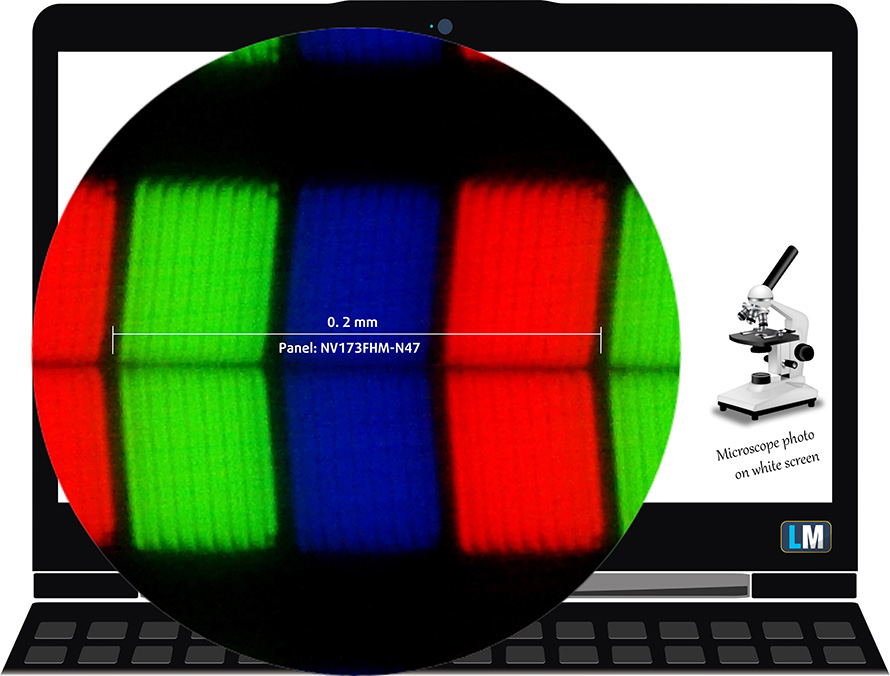
Its viewing angles are comfortable. We have provided images at 45 degrees to evaluate quality.

The maximum measured brightness is 350 nits (cd/m2) in the middle of the screen and 324 nits (cd/m2) average across the surface with a maximum deviation of 12%. The Correlated Color Temperature on a white screen and at maximum brightness is 7300K (average) – colder than the 6500K optimum for sRGB.
In the illustration below you can see how the display performs from a uniformity perspective. The illustration below shows how matters are for operational brightness levels (approximately 140 nits) – in this particular case at 81% Brightness (White level = 143 cd/m2, Black level = 0.14 cd/m2).
Values of dE2000 over 4.0 should not occur, and this parameter is one of the first you should check if you intend to use the laptop for color-sensitive work (a maximum tolerance of 2.0 ). The contrast ratio is good – 1030:1.
To make sure we are on the same page, we would like to give you a little introduction to the sRGB color gamut and the Adobe RGB. To start, there’s the CIE 1976 Uniform Chromaticity Diagram that represents the visible specter of colors by the human eye, giving you a better perception of the color gamut coverage and the color accuracy.
Inside the black triangle, you will see the standard color gamut (sRGB) that is being used by millions of people on HDTV and on the web. As for the Adobe RGB, this is used in professional cameras, monitors, etc for printing. Basically, colors inside the black triangle are used by everyone and this is the essential part of the color quality and color accuracy of a mainstream notebook.
Still, we’ve included other color spaces like the famous DCI-P3 standard used by movie studios, as well as the digital UHD Rec.2020 standard. Rec.2020, however, is still a thing of the future and it’s difficult for today’s displays to cover that well. We’ve also included the so-called Michael Pointer gamut, or Pointer’s gamut, which represents the colors that naturally occur around us every day.
The yellow dotted line shows Lenovo Legion 5i 17’s color gamut coverage.
Its display covers 92% of the sRGB/ITU-R BT.709 (web/HDTV standard) in CIE1976, which provides a vibrant and punchy image.
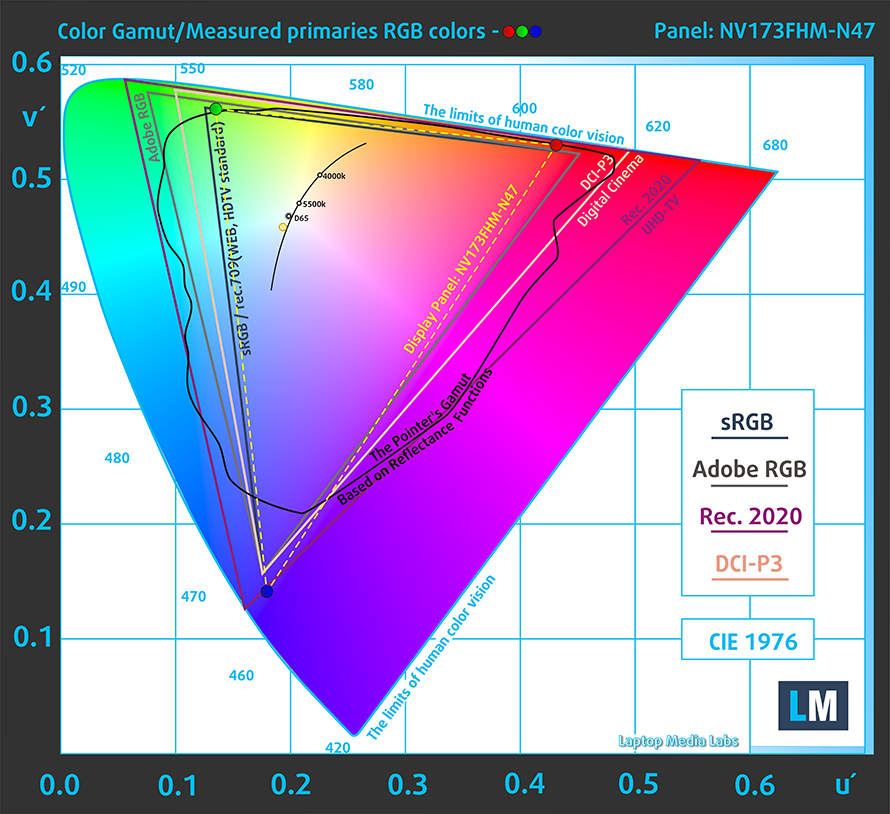
Our “Design and Gaming” profile delivers optimal color temperature (6500K) at 140 cd/m2 luminance and sRGB gamma mode.
We tested the accuracy of the display with 24 commonly used colors like light and dark human skin, blue sky, green grass, orange, etc. You can check out the results at factory condition and also, with the “Design and Gaming” profile.
Below you can compare the scores of Lenovo Legion 5i 17 with the default settings (left), and with the “Gaming and Web design” profile (right).
The left side of the image represents the display with stock settings, while the right one is with the “Gaming and Web Design” profile activated. On the horizontal axis, you will find the grayscale, and on the vertical axis – the luminance of the display. On the two graphs below you can easily check for yourself how your display handles the darkest nuances but keep in mind that this also depends on the settings of your current display, the calibration, the viewing angle, and the surrounding light conditions.
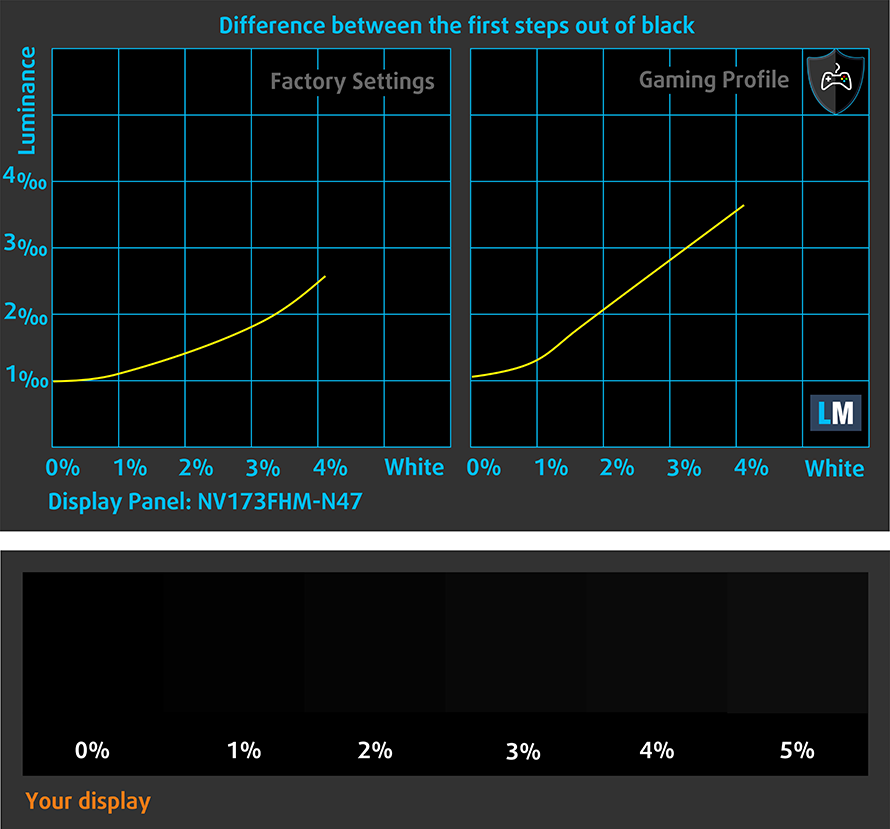
Response time (Gaming capabilities)
We test the reaction time of the pixels with the usual “black-to-white” and “white-to-black” method from 10% to 90% and vice versa.
We recorded Fall Time + Rise Time = 23 ms
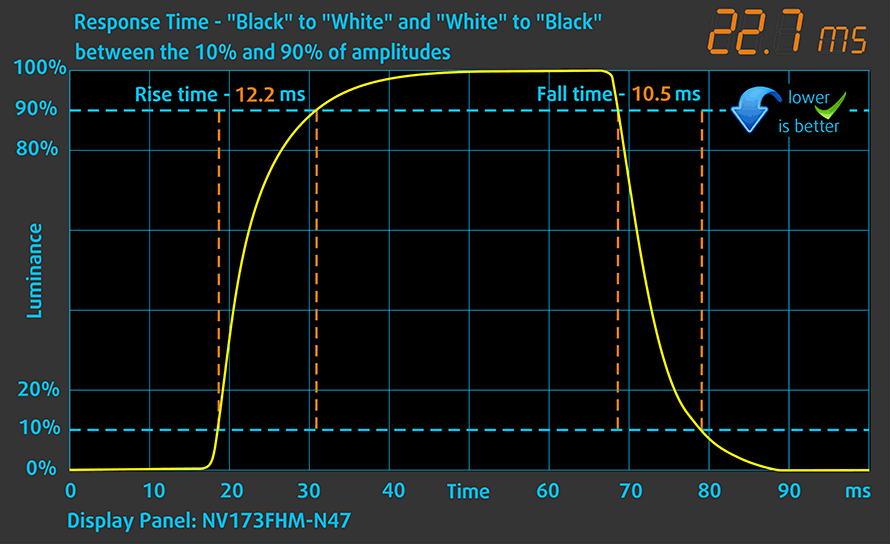
Health impact – PWM / Blue Light
PWM (Screen flickering)
Pulse-width modulation (PWM) is an easy way to control monitor brightness. When you lower the brightness, the light intensity of the backlight is not lowered, but instead turned off and on by the electronics with a frequency indistinguishable to the human eye. In these light impulses, the light/no-light time ratio varies, while brightness remains unchanged, which is harmful to your eyes. You can read more about that in our dedicated article on PWM.
Lenovo Legion 5i 17’s display doesn’t use PWM for brightness adjustment. This makes it comfortable for long working periods, without being harmful to your eyes in this aspect.
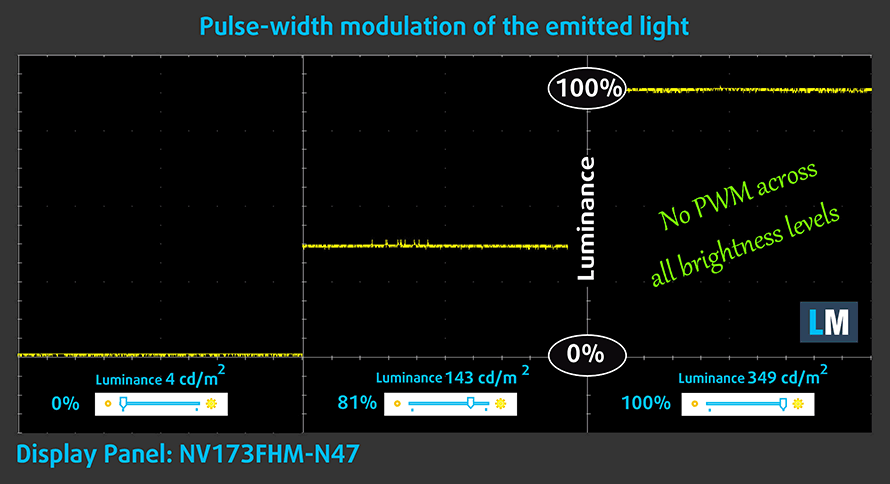
Blue light emissions
Installing our Health-Guard profile not only eliminates PWM but also reduces the harmful Blue Light emissions while keeping the colors of the screen perceptually accurate. If you’re not familiar with the Blue light, the TL;DR version is – emissions that negatively affect your eyes, skin, and your whole body. You can find more information about that in our dedicated article on Blue Light.
Conclusions
Lenovo Legion 5i 17’s 60Hz IPS panel has a Full HD resolution, good contrast ratio, and comfortable viewing angles. Moreover, it has a pretty high color coverage (92% of the sRGB gamut), and it’s backlight doesn’t use PWM. We were also surprised to see that the panel can be used for color-sensitive work with our Gaming and Web design profile applied. Together with the relatively high performance, it can be a great asset to architects and 3D animators on a small scale.
Buy our profiles
Since our profiles are tailored for each individual display model, this article and its respective profile package are meant for Lenovo Legion 5i 17 configurations with 17.3″ BOE NV173FHM-N47 (BOE0838) (FHD, 1920 × 1080) IPS.
*Should you have problems with downloading the purchased file, try using a different browser to open the link you’ll receive via e-mail. If the download target is a .php file instead of an archive, change the file extension to .zip or contact us at [email protected].
Read more about the profiles HERE.
In addition to receiving efficient and health-friendly profiles, by buying LaptopMedia's products you also support the development of our labs, where we test devices in order to produce the most objective reviews possible.

Office Work
Office Work should be used mostly by users who spend most of the time looking at pieces of text, tables or just surfing. This profile aims to deliver better distinctness and clarity by keeping a flat gamma curve (2.20), native color temperature and perceptually accurate colors.

Design and Gaming
This profile is aimed at designers who work with colors professionally, and for games and movies as well. Design and Gaming takes display panels to their limits, making them as accurate as possible in the sRGB IEC61966-2-1 standard for Web and HDTV, at white point D65.

Health-Guard
Health-Guard eliminates the harmful Pulse-Width Modulation (PWM) and reduces the negative Blue Light which affects our eyes and body. Since it’s custom tailored for every panel, it manages to keep the colors perceptually accurate. Health-Guard simulates paper so the pressure on the eyes is greatly reduced.
Get all 3 profiles with 33% discount
Sound
Lenovo Legion 5i 17’s 2W Harman-tuned speakers produce a loud and clear sound with very good quality.
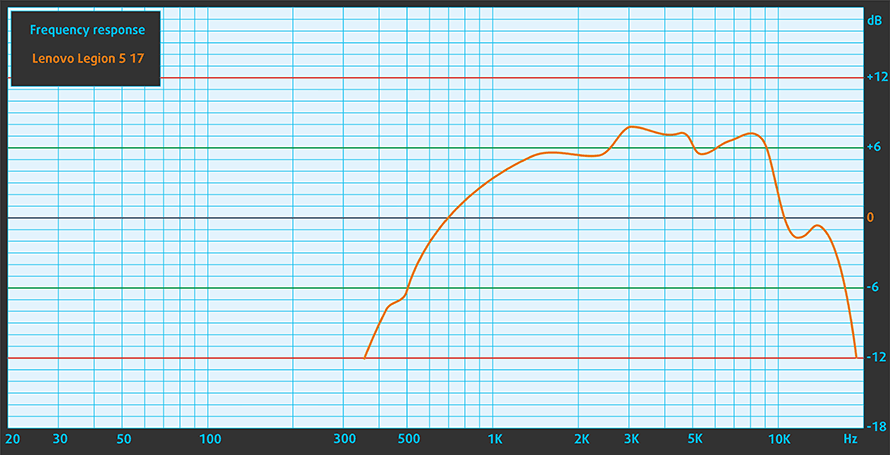
Drivers
All of the drivers and utilities for this notebook can be found here: https://pcsupport.lenovo.com/us/en/products/laptops-and-netbooks/legion-series/legion-5-17imh05/downloads/driver-list
Battery
Now, we conduct the battery tests with Windows Better performance setting turned on, screen brightness adjusted to 120 nits, and all other programs turned off except for the one we are testing the notebook with. This notebook’s 80Wh battery lasted for 9 hours and 22 minutes of Web browsing and 8 hours and 26 minutes of video playback.
In order to simulate real-life conditions, we used our own script for automatic web browsing through over 70 websites.
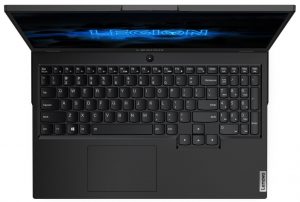



For every test like this, we use the same video in HD.




CPU options
Lenovo Legion 5i 17 comes with either the Core i5-1030HH, Core i7-10750H, or the Core i7-10875H, respectively 4,6, and 8-core processors.
Results are from the Cinebench 20 CPU test (the higher the score, the better)
Results are from our Photoshop benchmark test (the lower the score, the better)
GPU options
We were able to find the device in configurations, including the GTX 1650, GTX 1650 Ti, GTX 1660 Ti, and the RTX 2060.
Results are from the 3DMark: Time Spy (Graphics) benchmark (higher the score, the better)
Results are from the 3DMark: Fire Strike (Graphics) benchmark (higher the score, the better)
Results are from the Unigine Superposition benchmark (higher the score, the better)
Gaming tests

| Far Cry 5 | Full HD, Normal (Check settings) | Full HD, High (Check settings) | Full HD, Ultra (Check settings) |
|---|---|---|---|
| NVIDIA GeForce GTX 1650 Ti | 70 fps | 65 fps | 61 fps |

| Rise of the Tomb Raider (2016) | Full HD, Lowest (Check settings) | Full HD, Medium (Check settings) | Full HD, Very High (Check settings) |
|---|---|---|---|
| NVIDIA GeForce GTX 1650 Ti | 119 fps | 88 fps | 44 fps |

| Shadow of the Tomb Raider (2018) | Full HD, Lowest (Check settings) | Full HD, Medium (Check settings) | Full HD, High (Check settings) |
|---|---|---|---|
| NVIDIA GeForce GTX 1650 Ti | 95 fps | 61 fps | 54 fps |

| Tom Clancy’s Ghost Recon Wildlands | Full HD, Medium (Check settings) | Full HD, High (Check settings) | Full HD, Very High (Check settings) |
|---|---|---|---|
| NVIDIA GeForce GTX 1650 Ti | 63 fps | 58 fps | 52 fps |
Temperatures and comfort
Max CPU load
In this test we use 100% on the CPU cores, monitoring their frequencies and chip temperature. The first column shows a computer’s reaction to a short load (2-10 seconds), the second column simulates a serious task (between 15 and 30 seconds), and the third column is a good indicator of how good the laptop is for long loads such as video rendering.
Average core frequency (base frequency + X); CPU temp.
| Intel Core i7-10750H (45W TDP) | 0:02 – 0:10 sec | 0:15 – 0:30 sec | 10:00 – 15:00 min |
|---|---|---|---|
| Lenovo Legion 5i 17 | 3.81 GHz (B+47%) @ 77°C | 3.78 GHz (B+45%) @ 90°C | 3.46 GHz (B+33%) @ 78°C |
| MSI GF75 Thin 10Sx | 3.95 GHz (B+52%) @ 94°C | 3.62 GHz (B+39%) @ 94°C | 3.22 GHz (B+24%) @ 95°C |
| Dell G7 17 7700 | 3.84 GHz (B+48%) @ 94°C | 3.70 GHz (B+42%) @ 95°C | 3.48 GHz (B+34%) @ 98°C |
| HP Omen 15 2019 (15-dh1000) | 4.03 GHz (B+55%) @ 96°C | 3.87 GHz (B+45%) @ 97°C | 3.65 GHz (B+40%) @ 96°C |
| HP Pavilion Gaming 16 (16-a0000) | 3.74 GHz (B+44%) @ 97°C | 3.17 GHz (B+22%) @ 88°C | 2.98 GHz (B+15%) @ 78°C |
| Acer Predator Helios 300 (PH315-53) | 3.56 GHz (B+37%) @ 76°C | 3.52 GHz (B+35%) @ 85°C | 2.98 GHz (B+15%) @ 75°C |
| Dell G5 15 5500 | 3.82 GHz (B+47%) @ 75°C | 3.63 GHz (B+40%) @ 99°C | 3.01 GHz (B+16%) @ 81°C |
| ASUS ROG Strix G15 G512 | 4.16 GHz (B+60%) @ 81°C | 3.99 GHz (B+53%) @ 95°C | 3.52 GHz (B+35%) @ 87°C |
| Lenovo Legion 7 (15) | 3.78 GHz (B+45%) @ 80°C | 3.69 GHz (B+42%) @ 83°C | 3.51 GHz (B+35%) @ 83°C |
Honestly, the CPU results were pretty impressive, but they are not near as overwhelming as the GPU ones.
Real-life gaming
| NVIDIA GeForce GTX 1650 Ti | GPU frequency/ Core temp (after 2 min) | GPU frequency/ Core temp (after 30 min) | GPU frequency/ Core temp (Turbo mode) |
|---|---|---|---|
| Lenovo Legion 5i 17 | 1644 MHz @ 60°C | 1638 MHz @ 62°C | – |
| ASUS ROG Strix G15 G512 | 1647 MHz @ 66°C | 1626 MHz @ 70°C | – |
| Acer Nitro 5 (AN515-55) | 1628 MHz @ 74°C | 1601 MHz @ 81°C | – |
| Acer Predator Triton 300 (PT315-52) | 1581 MHz @ 70°C | 1551 MHz @ 78°C | 1673 MHz @ 66°C |
| ASUS TUF A15 (F506) | 1566 MHz @ 68°C | 1549 MHz @ 69°C | – |
Here, we can see a considerable advantage over pretty much the entire competition. Not that much in frequency, but more in the thermals. Keep in mind we’re talking about a 50W TGP.
Gaming comfort
Additionally, the low heat on the inside translates to a relatively cool keyboard to the touch – even at its hottest spot. Also, the fans were spinning way off their full potential, so the noise levels are rather comfortable as well.

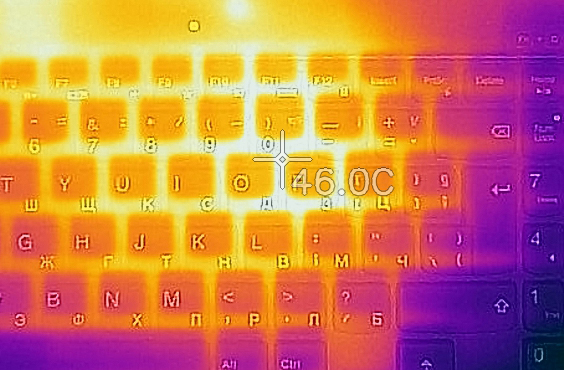
Verdict
 There are definitely some compromises made in order to keep the price down. However, they are massively outweighed by all of the features and perks this unit has. Ultimately, we run all of our tests with the Extreme Performance preset, which is activated by the “Fn+Q” key combination. Nevertheless, it extracted everything out of the GTX 1650 Ti, which is a budget-conscious, but very capable GPU.
There are definitely some compromises made in order to keep the price down. However, they are massively outweighed by all of the features and perks this unit has. Ultimately, we run all of our tests with the Extreme Performance preset, which is activated by the “Fn+Q” key combination. Nevertheless, it extracted everything out of the GTX 1650 Ti, which is a budget-conscious, but very capable GPU.
Ultimately, we were impressed by the battery, which lasted for 9 hours and 22 minutes of Web browsing and 8 hours and 26 minutes of video playback, meaning it can act like a normal 17-inch media consumption device. Additionally, the I/O is packed, and although it lacks Thunderbolt connectivity, it can be forgiven because of the total of 5 USB ports (one of the Type-C with DisplayPort output), as well as an SD card reader.
Lenovo Legion 5i 17’s 60Hz IPS panel (BOE NV173FHM-N47 (BOE0838)) has a Full HD resolution, good contrast ratio, and comfortable viewing angles. Moreover, it has a pretty high color coverage (92% of the sRGB gamut), and it’s backlight doesn’t use PWM. We were also surprised to see that the panel can be used for color-sensitive work with our Gaming and Web design profile applied. Together with the relatively high performance, it can be a great asset to architects and 3D animators on a small scale.
And this is exactly why we would strongly recommend this machine for photographers, video editors and not on the last place – gamers. Although, if you are a gamer, the 144Hz display option would be a better choice.
Despite the all-plastic structure, the notebook is well-built, the lid opens with a single hand, and it looks very sleek for a gaming machine. Also, the upgradeability is on point, thanks to the dual-channel memory, and the M.2 and 2.5-inch SATA storage drive options.
Not on the last place – this the Legion 5i 17 owns perhaps the best keyboard on a gaming device in this category (and size). The feedback and the huge Arrow keys are a dream for most titles. So, are on for a purchase of a 17-inch gaming device that isn’t going to annihilate your bank account, this is a great choice. Also, take a look at the ASUS TUF A17 (A706), which has the support of AMD’s Zen 2 architecture.
Pros
- Supports up to 64GB of DDR4 memory plus M.2 and 2.5-inch SATA storage
- Very good performance and thermals
- Lack of PWM (BOE NV173FHM-N47)
- Covers 92% of sRGB and our Gaming and Web design profile improves the color accuracy (BOE NV173FHM-N47)
- Has a very fine keyboard with huge Arrow keys
- Good battery life
- A total of 5 USB Ports, an SD card reader, and Wi-Fi 6 support
Cons
- Lacks a Thunderbolt connection
- All-plastic design, although the quality is pretty high
You can check the prices and configurations in our Specs System: https://laptopmedia.com/series/lenovo-legion-5i-17/

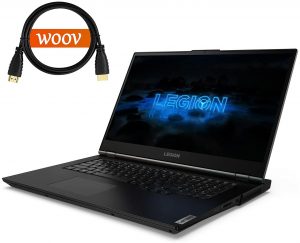
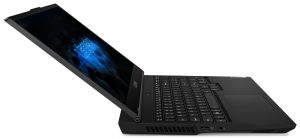
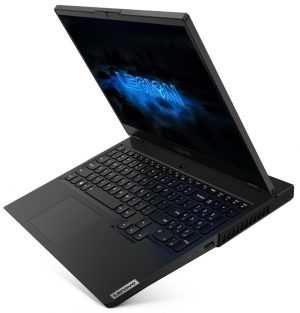
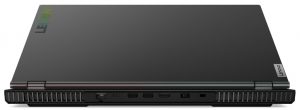
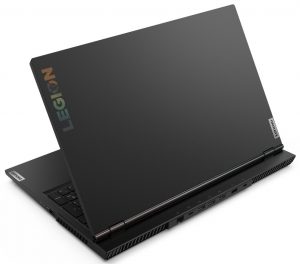
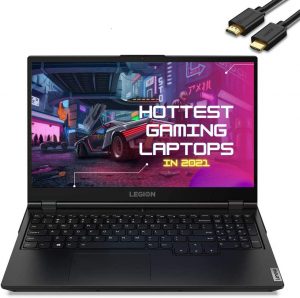

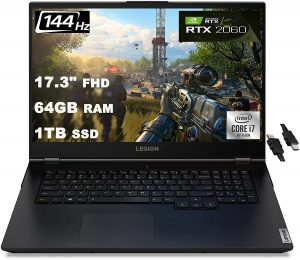
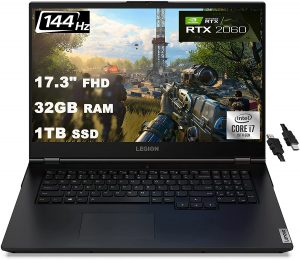
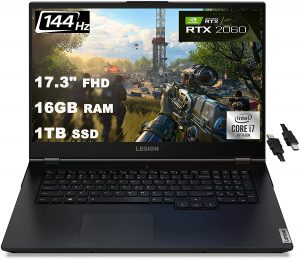
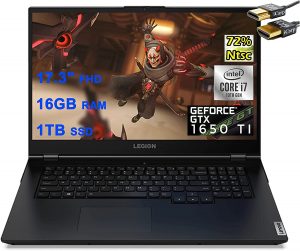
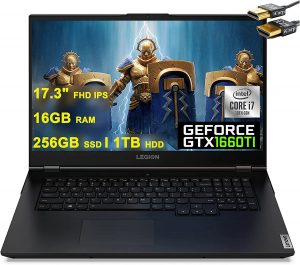

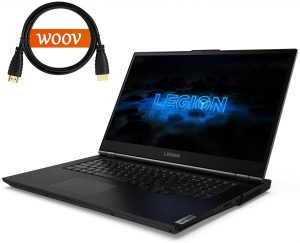

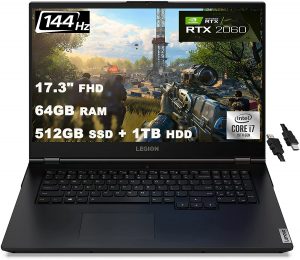
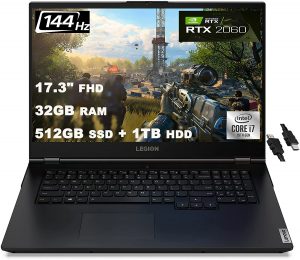
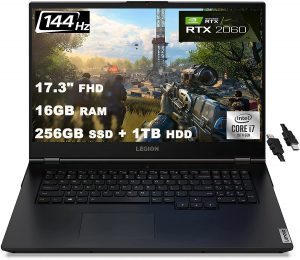
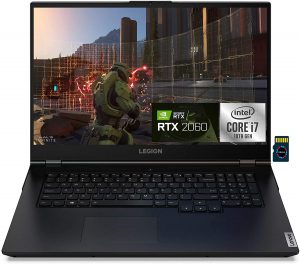
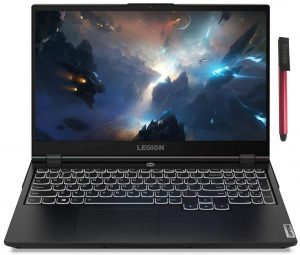
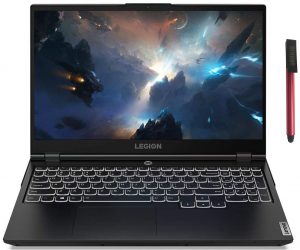
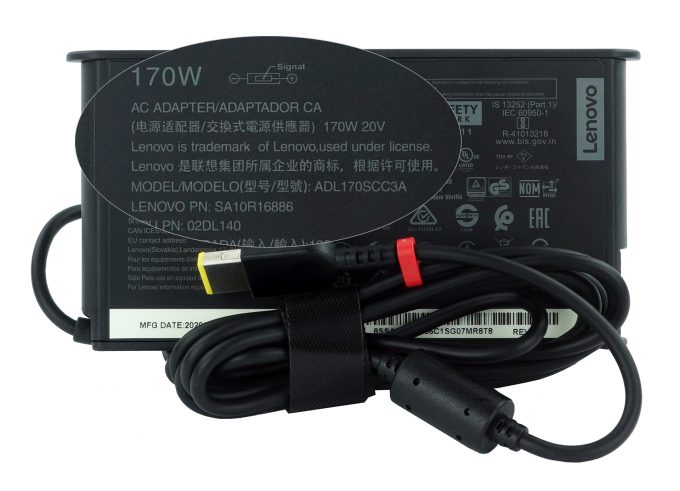
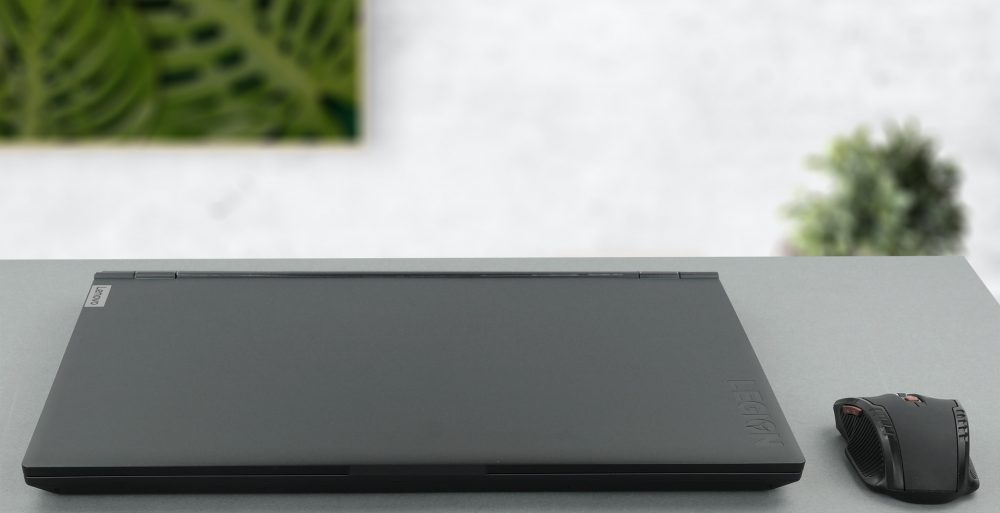
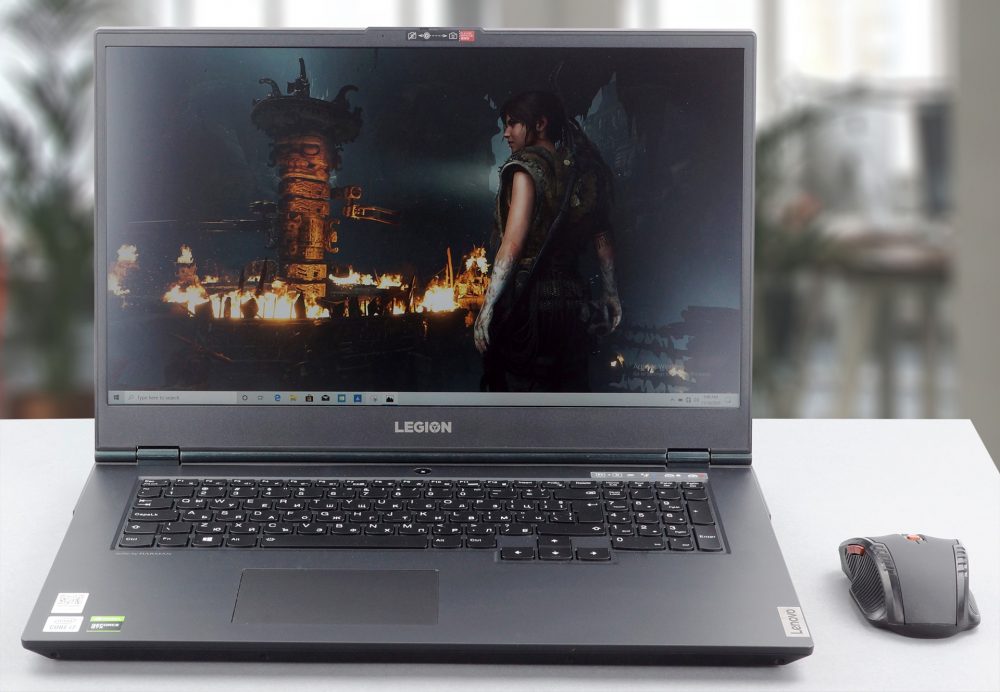
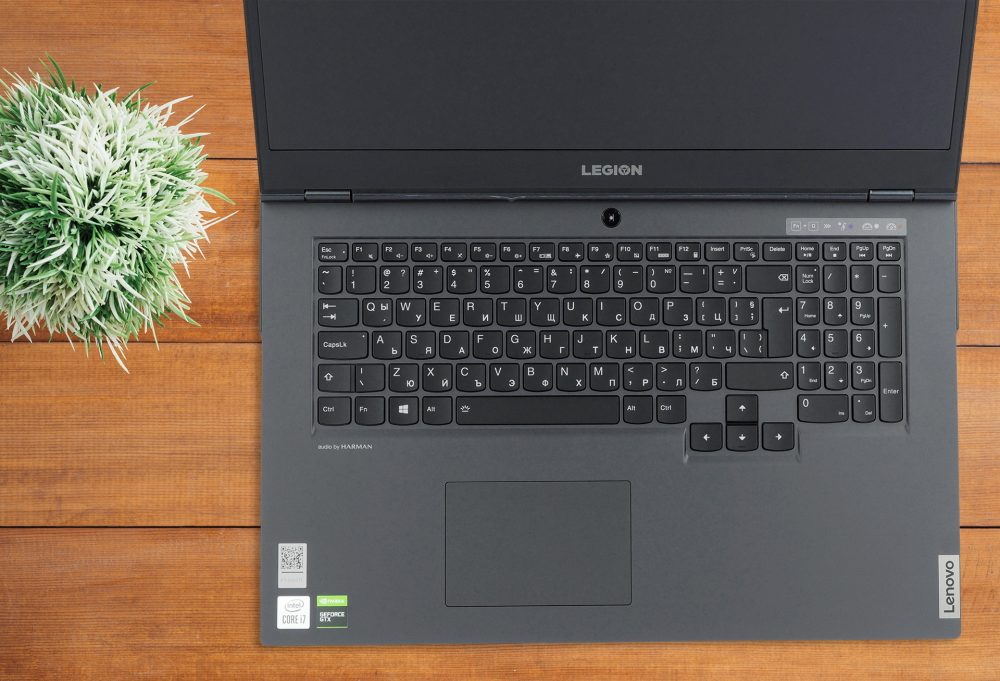
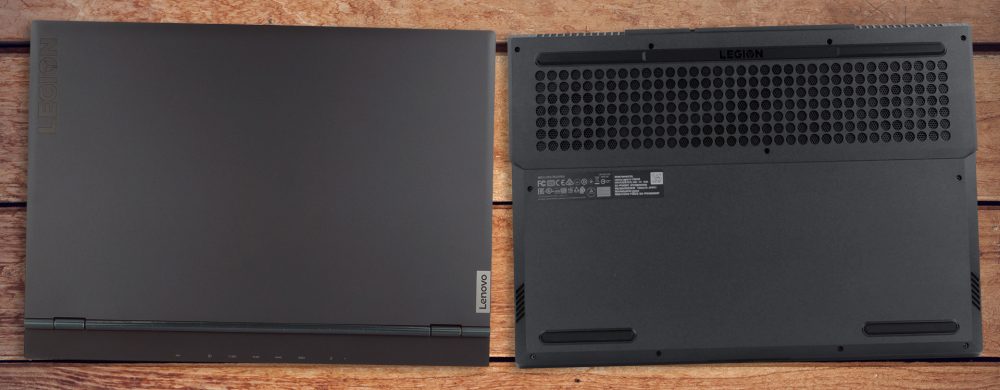
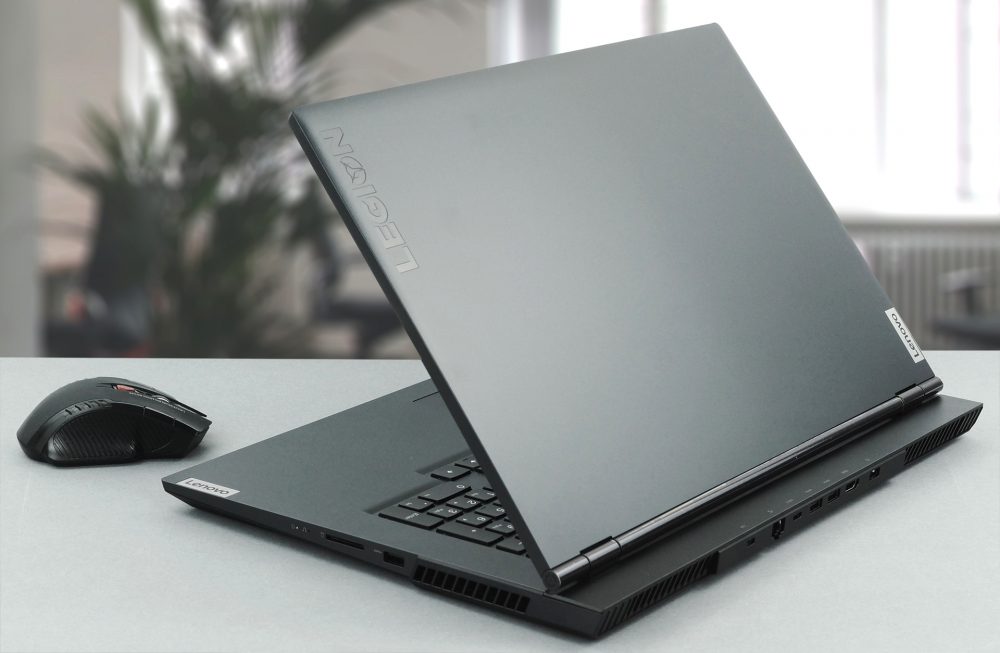




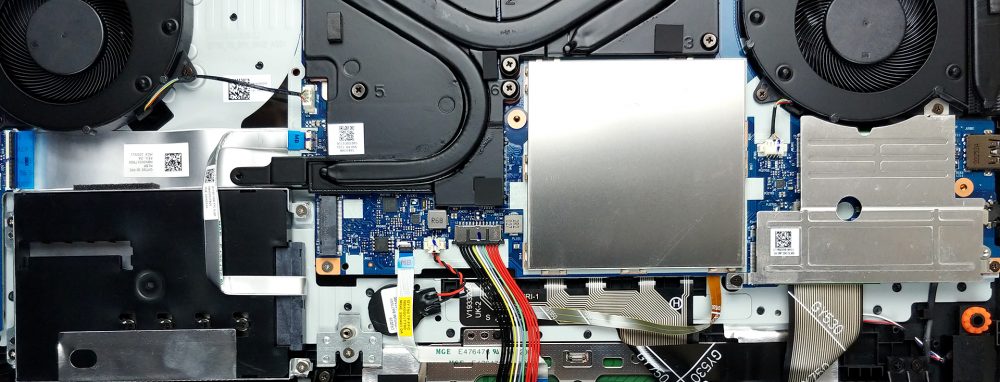
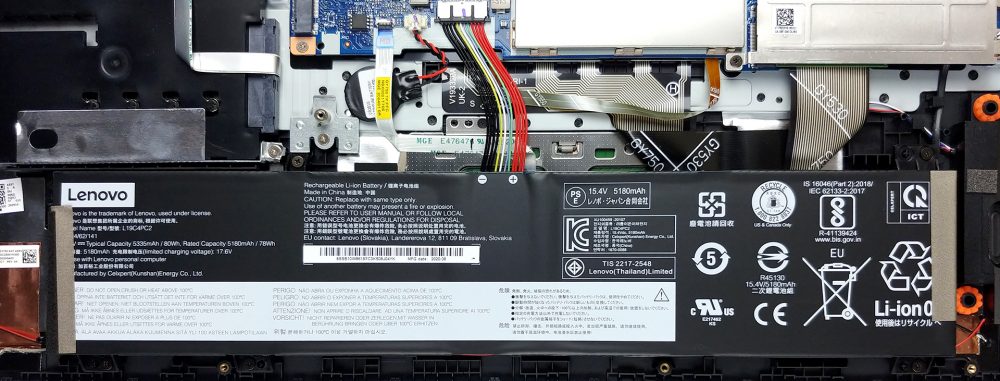
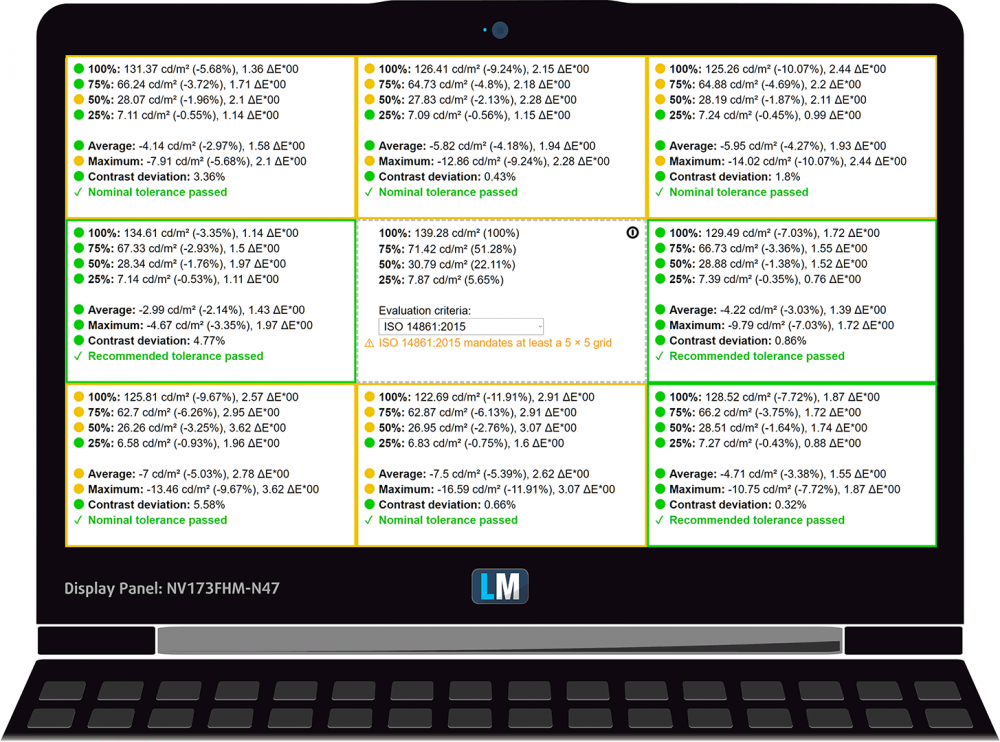
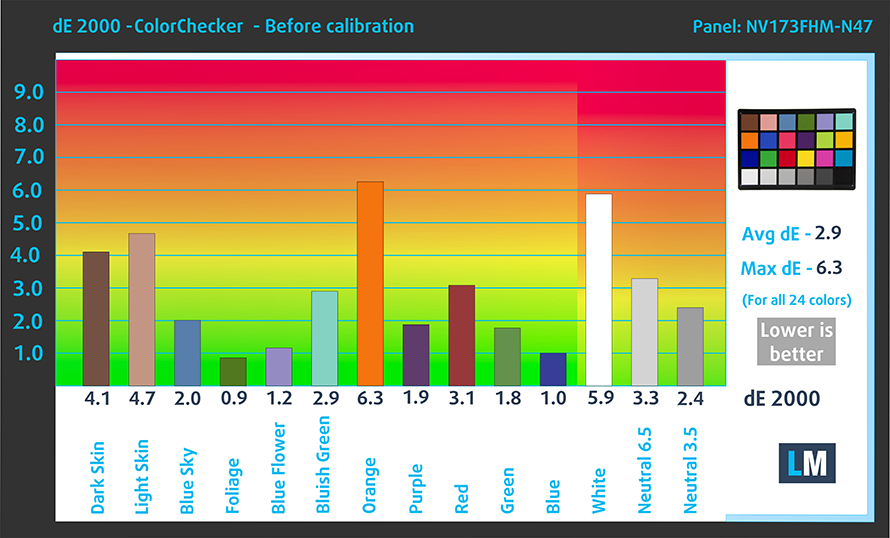


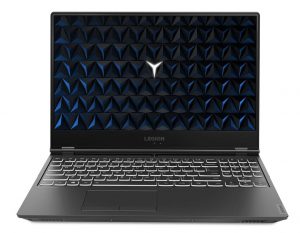
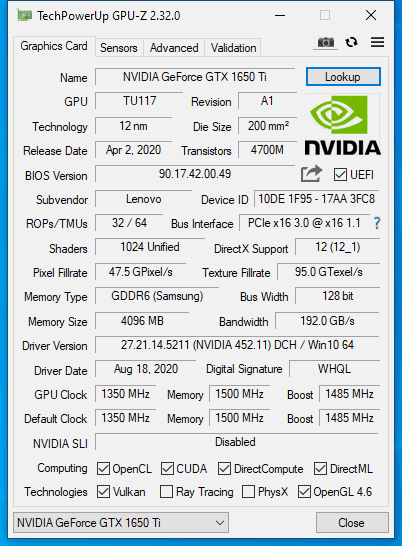








No touchpad buttons, no sale. Shame because they had it in previous gen Legion Y740 17 and removed them.
Nowadays webcam and builtin mic are getting more important. Can you start adding to your reviews sample recording of video and voice from webcam and mic?
fake hdr : dolby vision or real , really active in youtube?